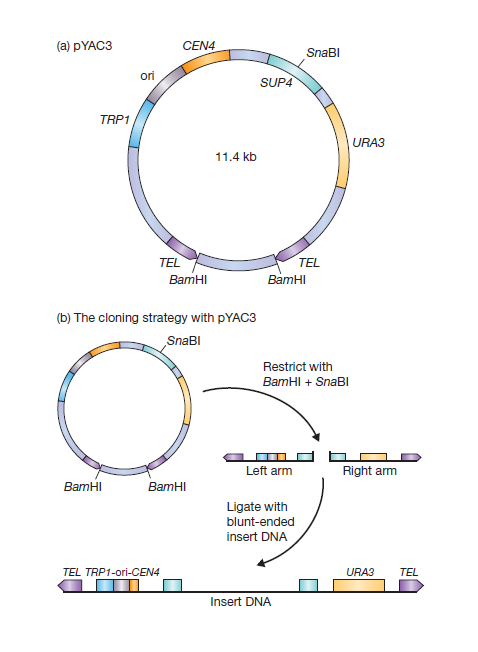Yeast artificial chromosome
Yeast artificial chromosome (YAC) is a human-engineered DNA molecule used to clone DNA sequences in yeast cells. YACs are often used in connection with the mapping and sequencing of genomes. Segments of an organism's DNA, up to one million base pairs in length, can be inserted into YACs. The YACs, with their inserted DNA, are then taken up by yeast cells. As the yeast cells grow and divide, they amplify the YAC DNA, which can be isolated and used for DNA mapping and sequencing.[10] It is abbreviation is YAC.
They carry large amounts of DNA so a long distance map of the region can be obtained in several steps. The repetitive rAegions may be 10-20 kb in length they are rarely longer than 50 kb. Thus a YAC with 100kb will contain some region that is single copy which can be used for further steps in the walk.
Features of YACs[11]
1. Large DNA (>100 kb) is ligated between two arms. Each arm ends with a yeast telomere so that the product can be stabilized in the yeast cell. Interestingly, larger YACs are more stable than shorter ones, which favors cloning of large stretches of DNA.[11]
2. One arm contains an autonomous replication sequence (ARS), a centromere (CEN) and aselectable marker (trp1). The other arm contains a second selectable marker (ura3).[11]
3. Insertion of DNA into the cloning site inactivates a mutant expressed in the vector DNA and red yeast colonies appear.
4. Transformants are identified as those red colonies which grow in a yeast cell that is mutant for trp1 and ura3. This ensures that the cell has received an artificial chromosome with both telomeres (because of complementation of the two mutants) and the artificial chromosome contains insert DNA (because the cell is red).[11]
Exaple : pYAC3
It is essentially a pBR322 plasmid into which a number of yeast genes have been insered.
pYAC3 is essentially a pBR322 plasmid into which a number of yeast genes have been inserted. Two of these genes, URA3 and TRP1, have been encountered already as the selectable markers for YIp5 and YRp7, respectively. As in YRp7, the DNA fragment that carries TRP1 also contains an origin of replication, but in pYAC3 this fragment is extended even further to include the sequence called CEN4, which is the DNA from the centromere region of chromosome 4. The TRP1–origin–CEN4 fragment therefore contains two of the three components of the artificial chromosome. [4]
The third component, the telomeres, is provided by the two sequences called TEL. [4]
These are not themselves complete telomere sequences, but once inside the yeast nucleus they act as seeding sequences onto which telomeres will be built. This just leaves one other part of pYAC3 that has not been mentioned: SUP4, which is the selectable marker into which new DNA is inserted during the cloning experiment. [4]
Image courtesy:
- http://www.genome.gov/glossary/?id=211
- http://www.ndsu.edu/pubweb/~mcclean/plsc731/cloning/cloning5.htm
- Gene Cloning & DNA Analysis- An Introduction, T.A.Brown. fifth edition, blackwell publishing, 2006
